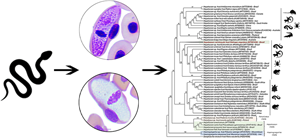Published online by Cambridge University Press: 03 August 2022

The combined use of molecular and microscopic techniques has become an increasingly common and efficient practice for the taxonomic and evolutionary understanding of single-celled parasites such as haemogregarines. Based on this integrative approach, we characterized Hepatozoon found in Helicops angulatus snakes from the Eastern Amazonia, Brazil. The gamonts observed caused cell hypertrophy and were extremely elongated and, in some cases, piriform (mean dimensions: 25.3 ± 1.9 × 8.6 ± 1.3 μm). These morphological features correspond to Hepatozoon carinicauda, described 50 years ago in the snake Helicops carinicaudus in the southeast region of Brazil. Phylogenetic and genetic divergence analyses, performed with the sequence obtained from the amplification of a 590 bp fragment of the 18S rRNA gene, revealed that Hepatozoon in He. angulatus differed from the other lineages retrieved from GenBank, and was clustered singly in both the phylogenetic tree and the haplotype network. The integration of these data allowed the identification of H. carinicauda in a new aquatic host, and increased the knowledge of its geographical distribution. Therefore, the present study included the first redescription of a Hepatozoon species in a snake from the Brazilian Amazon.